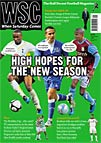 Dynamo Kiev's Soviet Supreme League triumph in 1975 put the club on the way to being the most successful team in league history. Saul Pope reports
Dynamo Kiev's Soviet Supreme League triumph in 1975 put the club on the way to being the most successful team in league history. Saul Pope reports
The long-term significance
Dynamo Kiev were midway through a run that would ultimately see them win more Soviet league titles than any other side. Spartak Moscow picked up six titles through the Fifties and Sixties but Dynamo accumulated eight through the Seventies and Eighties, leaving them with a total of 13 titles to Spartak’s 12. A large part of Dynamo’s success could be attributed to manager Valeriy Lobanovsky, a pioneer of football science who used physical and psychological testing to evaluate players’ potential and blended the total football of the era’s Dutch sides with tactical discipline. As well as winning the league in 1975, Lobanovsky’s Dynamo won the Cup-Winners Cup. They would repeat this feat in 1986 before Lobanovsky led the USSR to the Euro 88 finals and Dynamo to the Champions League semi-final in 1999. The English FA’s forthcoming National Football Centre is partly based on the training centre he built for his Dynamo side in the Seventies.
Story of the season
Kiev were dominant in repeating their 1974 title. Two of their defeats came at the hands of relegated Pakhtakor Tashkent, including a 5-0 thrashing in the Uzbek capital. Kiev comprehensively dispatched Ferencvaros 3-0 in the Cup-Winners Cup final, having beaten PSV Eindhoven in the semis. 1973 Soviet champions Ararat Yerevan also had a good European season – they appeared for the first and only time in the European Cup and reached the quarter-finals, where they lost 2-1 on aggregate to eventual winners Bayern Munich. It was largely Ararat’s failure to deal with the top three – they took just three points from six matches – that prevented them from finishing higher, but a consolation was to win the Soviet Cup. Second place was contested by several sides, with Shakhtar Donetsk winning the silver medal thanks to a 3-0 final day victory over Ararat. Like their Ukrainian compatriots in Kiev, Shakhtar were about to embark on their most successful period, culminating in a further silver in 1979 and winning the Soviet Cup in 1980. Newly promoted SKA Rostov lost their first four league games and never recovered, despite changing their manager twice. There were highlights – three of their four victories came against big sides (Ararat, Moscow Dynamo and Torpedo) and two of their players were called into the USSR national squad. Having been a strong side in the Sixties, this was the beginning of a period which would see them yo-yo between the top two divisions.
For the record books
Oleg Blokhin’s 18 goals for Dynamo made him top Soviet scorer for the fourth consecutive season. His achievements led to him being voted 1975 European Footballer of the Year, receiving almost three times as many points as second-placed Franz Beckenbauer. At home, and along with most of his Dynamo teammates, he was made an Honoured Master of Sport, given to those who were “ building Soviet physical culture”. Dynamo’s Cup-Winners Cup victory was a first European club trophy for the Soviet Union – prior to this only Dynamo Moscow had made the final, losing 3-2 to Rangers in 1972. The only other Soviet club to make a European final would be yet another Dynamo – Tbilisi – who won the 1981 Cup-Winners Cup.
Same place today
Many of the teams have gone on to dominate in their domestic leagues since the breakup of the Soviet Union. In Ukraine the Premier League has almost exclusively been a two-horse race between Dynamo and Shakhtar, and in Russia Spartak, Lokomotiv and CKSA have won 14 of 16 Russian titles. Ararat, Dynamo Tbilisi and Pakhtakor have been big players in the Armenian, Georgian and Uzbek top leagues respectively.
Moved furthest away
Only SKA Rostov have not played at the top level since the breakup – locally the club have been eclipsed by FC Rostov. SKA have spent most of the post-Soviet era playing at the third tier and spent 1998 playing amateur football after finishing bottom of the league. More recently they have been also-rans in the second level.
From WSC 271 September 2009